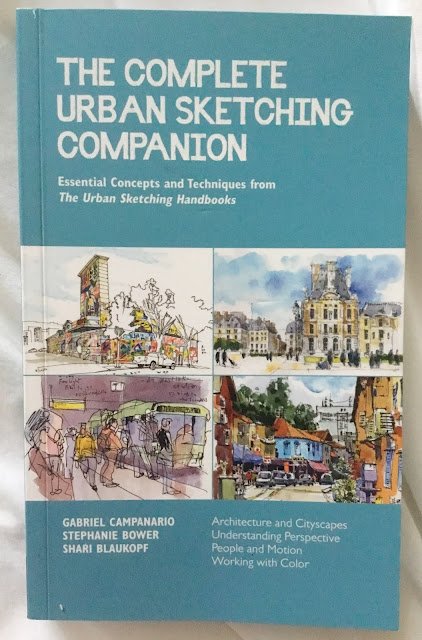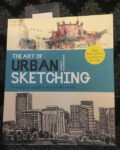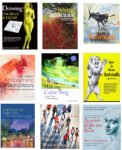I'm still making my way through my birthday books and this one has taken a…

The Complete Urban Sketching Companion, Gabriel Campanario, Stephanie Bower & Shari Blaukopf – Book Review
Another book review, only two days after the book was published. This is a 256-page, A5-sized paperback. It’s a mashup of four books from the Urban Sketching Handbook series:
– Architecture And Cityscapes by Gabriel Campanario
– Understanding Perspective by Stephanie Bower
– People And Motion by Gabriel Campanario
– Working With Colour by Shari Blaukopf
The temptation must have been there to just put all four books back to back and end up with a 448-page monster that had lots of repeated material within it (like Terry Harrison’s Complete Guide To Watercolour Landscapes) but that’s not what’s happened here. The four books have been mashed together into a single book that hangs together reasonably well.
So, what have they done? Well, each of the four original books is 112 pages long, has an introductory chapter, 5 or 6 chapters on different “keys” and then a gallery of artwork taking up about 15-20% of the book. In mashing the books together, the publishers have:
– discarded the galleries
– only put in a single introduction chapter on materials, etc. It looks to me like that chapter may have come from Shari’s book on colour
– kept almost all of the chapters on keys. Of 22 chapters in the original books, only three didn’t make it into this book (the Line and Creativity chapters from Architecture And Cityscapes and the Likeness chapter from People And Motion)
– (judging from the page counts on the contents pages) possibly shaved out the odd page here and there, with Understanding Perspective suffering the most.
In terms of writing style, I found myself warming to Shari in the introduction and In the section on colour. Her passion came through: it was as if she wanted to transfer over that passion as well as transferring over facts and tips. I found Gabriel’s and Stephanie’s style to be a bit more abrupt and rough, but this may be down to editing. They reminded me a bit of Garth Crooks on BBC Sport who likes to make an obvious point (“Things closer to you look bigger; things far from you look smaller and closer together”) and then make a serious looking pout as if he’s come up with the most profound point of all time.
And that brings me on to content. Were there any tasty nuggets of information in this book that made me think wow, what a great insight? In short, no. Or not many anyway. The Gabriel Campanario sections were particularly lacking in nuggets. There was absolutely nothing in the People And Motion section that I didn’t already know from reading the Lynne Chapman book. I didn’t learn much from the Stephanie Bower section on perspective, but this may be down to my grade A at O level technical drawing. I suspect a beginner would learn a lot more from that section. The section that was most interesting to me was the one on colour. Most of the stuff in that section was stuff I already knew but it was refreshing to hear someone else’s take on it and to see it reflected in their artwork.
And finally inspiration. The more books I read and the less that’s left for me to learn, the more important it is that the artwork in the book sends me thinking in new directions. Now, if this book were A4-sized like most art books, I’d be able to open it up and stare longingly at all the artwork within it. But this was an A5-sized paperback. This didn’t only mean that the pictures were smaller (only a quarter of the size they’d have been in an A4 book) but also that there were bits of pictures that I couldn’t see without cracking the spine of the book. Somehow, the pictures in Shari’s section (it’s always Shari) were more inspiring – maybe because they were more colourful, maybe because the text on the rest of the page was more passionate and exciting.
And then we get to the best bit of the book. Each of the four subbooks has a ticklist of challenges for the reader to attempt. This book brings them together into a list of 91 challenges to work through. And it’s an interesting set of challenges that’s definitely worth working through.
Overall it’s a slightly weird book. The first weird thing about it is that I’m not sure what target audience is. Most of the tips in the book are too basic for anyone with any experience and yet the tip-tip-tip-tip machine gun approach of three of the four sections is surely too cold and impersonal for a beginner? I’d probably be making exactly the same points about the individual subbooks. And I can see a much better book for these three authors to write just sitting there. It’s in those 91 challenges. Just imagine a book “91 Challenges For The Experienced Urban Sketcher”, or maybe 70 or 80 after pruning out crap like drawing cereal boxes. If there was a book with a double page devoted to each challenge with three or four examples in each case of how different artists had approached the challenge, that would make for a great book!
The other weird thing about this book is that it’s like a bad beat in poker. You have a great hand and the opponent puts you all in. You call. The only way you can lose is if the next card to be turned over is the king of spades. And there he is, king of spades, and you’ve lost a huge pot. But it was still a great decision to call. And in the same way, although there wasn’t much to learn from the book, I don’t regret putting it on my wishlist. If it wasn’t in my collection I’d still be pining for it, even after reading this review. So somehow it’s comforting to have it there.
Overall, this is a very easy rating. Two palettes. The archetypal two palette book.
Oh, and Gabriel Campanario’s book on The Art Of Urban Sketching still remains high on my wishlist, despite me being less than satisfied with his sections in this book. TAOUS is big enough to open up, is hugely thick and markets itself more as inspiration than as a learning source, so should be a very different experience, and may even have a similar feel to my hypothetical 91 Challenges book.
You can find this book and more reviews of it at Amazon UK here. As an Amazon Associate, I earn commission from qualifying purchases but this costs absolutely nothing extra to you.








Leave a Reply